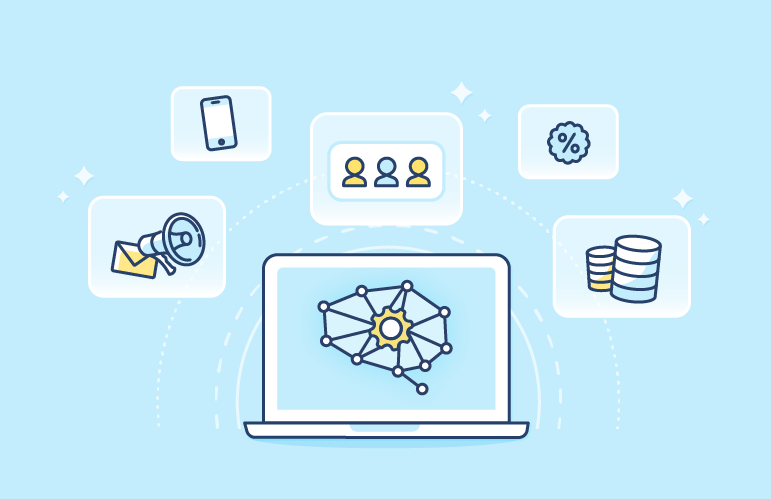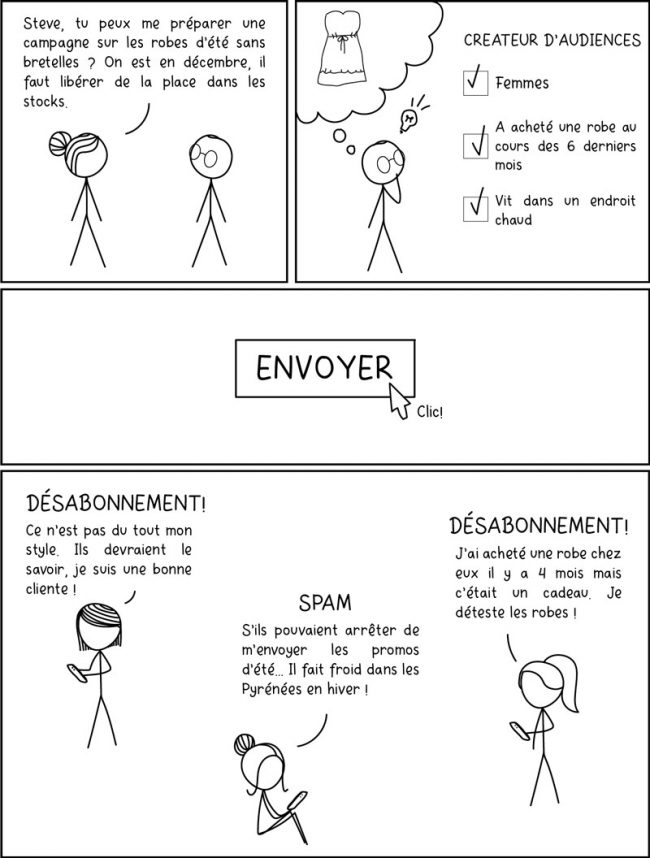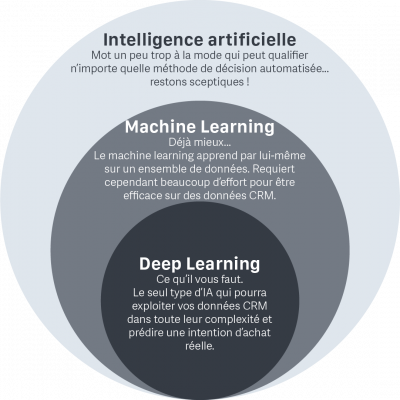The Marketer’s Guide to CRM Audience Building: What We’ve Been Doing Wrong All Along, and Why Plug & Play Deep Learning is the Solution


Catégorie : IA for CRM
Have you ever felt frustrated with your team’s CRM audience building process? Maybe you’ve wondered if your query criteria are too loosey-goosey?. Or how the process could possibly be so cumbersome?. Or maybe you’ve simply found yourself asking, In 2021, is there really no better way?
Alternatively, are you only sending Batch & Blast newsletters, but considering implementing a targeted approach in the near future – and possibly feeling overwhelmed by the implications in terms of data, segmentation, and bandwidth?
Or maybe you’re just curious to learn about AI applications in the field of B2C CRM marketing?
Whatever the case, I’ve got you covered. In this illustrated guide, I’ll go through a step-by-step explanation of what’s wrong with traditional audience-building methods, and a demonstration of why Deep Learning is the only way to do CRM Audience Building right (as well as a few other handy CRM marketing applications!).
But first, a quick note: this article is a little long.
To start things off, let’s get some definitions straight, seeing as different organizations tend to have varying terms for different types of CRM communications.
CRM communications usually fall under one of these categories:
Today’s focus will be on the latter. Campaigns usually make up about 90% of the CRM messages sent by a brand. They are used to communicate about new collections or products, sales, specific product categories, and more…
Typically, CRM teams start by implementing “Batch & Blast” campaigns – campaigns that they send to their whole customer base. However, they usually see the limits of Batch & Blast very quickly:
The logical next step is therefore to move on to targeted campaigns, featuring specific topics or offers to be sent to the subset of your customer base most interested in that particular content.
Why do CRM teams implement targeted campaigns? The reasons are many:
Attaining these objectives with targeted campaigns, however, is obviously subject to making the theory a reality: these campaigns do need to be as relevant as possible.
Success hinges on the assumption that the CRM team is able to identify, for each targeted campaign, the subset of customers that will be most interested in the campaign.
So how does one make a campaign relevant? The CRM team needs to identify, for each targeted campaign, the subset of customers that will be interested in the campaign topic(s),, engage with the campaign, and, ultimately, convert.
If this sounds easy, think again.
As marketers, we’ve all been taught to segment our market and put our customers in neat little boxes. We’ve practiced it so much, we forget that these customers are actual people, in all their complexity, with their lovable quirks, whims, ideas, spontaneity – in short, everything that makes them human.
Or maybe we don’t forget… but what other options do we have?
With traditional audience-building, human bias is built into the methodology.
In practice, this is what it looks like:

Of course, this is slightly caricatural. Hopefully the campaign above would generate some sales, and not just unsubscribes. But you get the point. The traditional, rule-based approach to campaign targeting has many flaws.
Your CRM first-party data is super rich. You have so many data points about your customers, their behavior, and your products.
And yet when building audiences as described above, there’s a double layer of biased simplification at play:
For both dimensions and values, the selections will be guided by intuition (best case) or guesses (worst case), and, invariably, will be plagued by our assumptions and biases.
Therefore, you can guess my next point…
Because this method is only a very rough attempt at “predicting” relevancy of the campaign
Extrapolating purchase history to predict future purchases will unfortunately trap your customers into their starting categories and you’ll be missing out on the opportunity to introduce them to additional offerings, even though those offerings might be relevant to them.
One pitfall of building criteria lists in the hope of narrowing down your audience is that you’re, you know, narrowing your audience. Actually, it’s really common for marketers to realize that their final audience is too small. So then they have to compromise, add new segments, remove some criteria… ending up where they started: with a broad and undefined target.
For audience-building, predicting the propensity to buy a given product is actually not enough. You want to predict propensity to buy at the time of the campaign send.
It’s not enough to say, “Steve has bought a dress in the past 6 months, therefore Steve will likely buy another dress someday” to include Steve in your dress campaign. Over a very long period of time, this statement stands a good chance of becoming true, but that doesn’t really help the campaign that you need to send tomorrow.
It would be much more powerful to be able to say, “Steve has a very high propensity to buy a dress this week, so let’s include him in tomorrow’s dress campaign”
Alright, I hope we’re now aligned on the limitations of traditional audience-building methods.
Luckily, there is a solution, and it is, of course, AI – more specifically, Deep Learning.
And when you think about it, it makes a lot of sense:
What are the similarities of audience-building with image recognition you might ask? Well:
1. In each of them we’re trying to answer a simple question… (Is this image a cat? Is Steve going to buy a trip to Thailand this week?)
2. In both cases, we have very rich, complex data available to help answer the question:
3. We might think we can focus on a small subset of criteria to answer our questions…
4. But we’ll find that even if we spend a very long time honing a criteria list, the success rate remains very weak.


5. However, in both cases, it is possible to generate a huge dataset of examples where the question has already been answered.
And we know that Deep Learning works amazingly well for image recognition. With a big enough dataset to learn from, the success rate is close to 100%. In some specific applications (medical imaging comes to mind), models are already more efficient than humans!
Deep Learning applied to image recognition (and in general) works much like the human brain does- the same way a child learns to recognize a cat not because he learns a list of criteria provided by its parents, but because they patiently show him pets and comment “this is a cat”, “this is a dog”.
Deep Learning applied to relational databases like a CRM dataset is much the same. It’ll learn from the entirety of your database, the trove of data we mentioned earlier, without discarding any datapoint or dimension, without being burdened by arbitrary rules. It’ll ingest all the edge cases that criteria would never capture, and incorporate them to tune ever-so-slightly its predictions.
Deep Learning will be able to detect subtleties like product lifecycle, seasonality, people’s “style”, people’s “unpredictability”… without any of these dimensions being specifically inscribed in your database.
Deep Learning can accurately predict that Mary is going to buy a vintage floral dress, even though Mary never bought a dress from you before -or anything tagged as “floral” or “vintage,” for that matter.
Of course, what I described above only applies to Deep Learning done right. You can’t just upload CRM tables in an algorithm for image recognition in order to get purchase intent predictions.
And similarly, we all know that AI and Machine Learning are pretty much buzzwords at this point. So here are a few points it’s good to have in mind when thinking about incorporating AI or Machine Learning into your CRM strategy (!):

Bingo! It sounds like Deep Learning is the appropriate form of AI for propensity-to-buy predictions.
Now, within the context of Deep Learning, important questions remain:
As is so often true, the actual value is in the chosen application, and the execution.
That is why so many “Deep Learning” frameworks are actually open-sourced or commercially available. Even though they’re really good building blocks, they will not get you very far on their own.
That is also a reason why, generally speaking, you should be suspicious of AI, Machine Learning, or Deep Learning applications that have not been developed for a very specific purpose, but for a wide variety of use cases. (Yes, I’m looking at you, Einstein and Watson).
Not all AI or Deep Learning is created equal.
In order for Deep Learning to be applied successfully to CRM audience building, it needs to follow some basic principles, which we can think about in terms of:
The one without the other would just mean that the application will never be used.
Let’s get some of the obvious practicality questions out of the way:
These do sound obvious (they’re why applications are called “solutions” and not “problems”!) but you might be surprised at the number of “solutions” that don’t tick these boxes.
That being said, let’s move on to the juicy, interesting parts.
This one is easy, both from the efficiency and the practicality point of view. We want results from Day One, that’s non-negotiable. The Deep Learning model has to be able to learn from historical data and have great predictive quality from the start. (More about this in this article by one of our data scientists – Warning: it’s a little bit more technical than what you’re reading right now).
It’s mostly a matter of efficiency: If these trends and behaviors aren’t reflected in the predictions, then the results are going to be mediocre at best. Purchase patterns are wildly different during the holiday season than, say, early spring!
To best account for seasonality, the model should be tuned to pay special attention to (learn predictive clues from) the most recent purchases of the offer it’s predicting propensity for!
Revenue, in most cases, rather than open rates, click rates, etc
In a given week, maybe 2% of your customers visit your website or make a transaction, giving you fresh data points.
Over 3 or 6 months, maybe it’s 20% or 30% of them?
What about the others, the vast majority of your customers for whom you do not have fresh data? You still want to be able to send them relevant communications. Maybe they’re even inactive, so the need for relevancy in order to reactivate them is even greater. That’s the pitfall of many personalization / product recommendation solutions: they do OK for customers with very fresh intent data, and are absolutely counter-productive for the rest.
Because very few humans buy only dresses, or only rugs, or only flights to Miami.
If John bought socks from you before, are you only ever going to send John emails about socks? If John visited your hotel in Chicago in the past, is he condemned to receiving “Chicago” communications forever? What if John loves to never visit the same place twice?
***
As you can see, there are many considerations that go into developing a Deep Learning model dedicated to predicting propensity to buy from a CRM dataset. So many, actually, that it’s never worth it for a B2C brand to build it internally: the level of expertise and development time required are prohibitive.
However, for teams of expert data-scientists whose sole focus for years is creating and refining such a model, it actually is possible… and it opens so many real-world marketing use cases!
There are endless practical applications of being able to accurately predict propensity to buy for each customer in your base, for each product or offering in your catalog. Here are a few of them:
The first one, obviously, is audience-building (good thing, seeing as it’s the topic of this article!).
Let’s say your Deep Learning algorithm can rank all of your customers from most likely to least likely to buy a given product. Then building the audience could be as easy as
CRM teams send many campaigns each week, sometimes multiple per day. But they might have a rule that no customer should receive, say, more than 3 messages per week, or more than one message per day.
What if a customer has a really high propensity to buy each of the products featured in a given day’s campaigns, though?
The propensity to buy information could be used by the solution to assign this customer to the one campaign for which his buying propensity is the highest, ensuring maximum relevancy while minimizing fatigue.
If you can get propensity to buy by customer x product, there’s no reason you couldn’t get propensity to buy by customer x product x channel.
Therefore adding one more dimension to all of the above!
Maybe there’s a specific subset of your customers who are really hot for a given product right now. It might not be visible in the KPIs available to the CRM team, because it’s not yet among the “best sellers”… but there’s a high demand concentrated among a small number of people. That’s the perfect audience for a targeted CRM campaign!
This information could be used to create a “heatmap” of your product catalog, letting you visualize these opportunities easily.
Should two products be featured in the same campaign, or in two distinct campaigns?
Well, the answer depends on whether the people interested in one, will also be interested in the other.
Guess how to get this information…
If you’ve made it this far in the article, thank you! I hope you found it interesting and instructive.
Interested in learning more? Check out our blog.
Sommaire